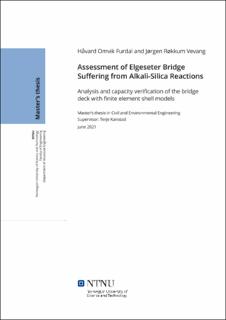| dc.description.abstract | This master’s thesis is a condition assessment of the plates in Elgeseter Bridge, focusing on the effects of alkali-silica reactions (ASR). Elgeseter Bridge is a 200 m long bridge with 9 spans and non-tensioned reinforcement. Core samples have revealed comprehensive ASR, and several cracks have been observed in both beams and columns. ASR is a chemical reaction in concrete occurring when alkali-reactive aggregates react with alkaline pore water. The reaction product, a swelling gel, causes a volu metric expansion of the concrete. Elgeseter Bridge is estimated to have elongated 180 mm since it was built in 1951. Local variations in the aggregate and different access to humidity have caused a varying degree of ASR within the structure. Both the global elongation and the varying expansion between components introduce additional forces in the bridge. In this study, dimensioning forces are obtained by a linear elastic finite element analysis (FEA) in Abaqus. Elgeseter Bridge is modelled with shell elements to de scribe the effects of simultaneously acting forces. The utilization of critical shell sections is assessed in the ultimate limit state through a capacity control using the Iteration Method. According to the capacity control, the most critical sections are located in the column axes in the middle of the plate between the inner and outer beams. If yielding in the reinforcement is considered as a failure criterion, the utilization ratio is 5.26 in a typical column axis and 6.25 in the northernmost column axis. The reinforcement is, in general, highly utilized in sections along column axes because of significant tensile forces. Yielding in the reinforcement is detected in 17 of the 32 controlled sections. Among these, 14 sections exceed their capacities if a failure strain of 10h in the reinforcement is used as the failure criterion. The capacity control reveals that 9 sections reach failure in the concrete before failure strain is obtained in the rein forcement. | en_US |

